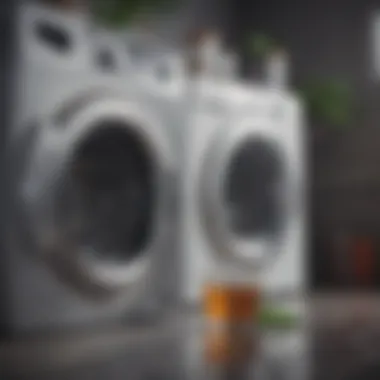Effective Household Items to Clean Your Washing Machine


Intro
Maintaining a washing machine is essential for prolonging its life and ensuring optimal performance. While we often focus on the laundry it handles, we neglect the machine itself. Over time, detergent residues, fabric softeners, and even lint can accumulate inside. This buildup can lead to unpleasant odors and reduced efficiency. Fortunately, many household items can effectively clean your washing machine.
In this guide, we will explore practical cleaning solutions that are readily available in your home. By understanding how to utilize these items wisely, you can enhance your appliance maintenance routine without needing specialized products. Regular care not only preserves the washing machine’s longevity but also ensures fresher laundry.
Let’s delve into the cleaning agents you can use and the methods involved to keep your washing machine in pristine conditions.
Understanding the Need for Cleaning
Cleaning the washing machine is not often thought about, but it plays a crucial role in maintaining household hygiene. Washing machines, by their very function, are vessels for dirt, detergent, and organic debris. Over time, residues can accumulate, leading to a host of issues if left unchecked. Regular maintenance is essential for ensuring the longevity of the appliance and the freshness of laundry.
Why Washing Machines Accumulate Dirt
Washing machines face several challenges that contribute to dirt accumulation. One significant factor is the use of detergent. Even high-quality detergents can leave behind residue. This residue combines with lint, hair, and other particles from clothes. Additionally, the damp environment inside the washer can promote mildew and mold growth. The hoses and drainage system can also harbor dirt and bacteria if not properly cleaned.
Another point is the type of clothing washed. Heavily soiled items, such as sports gear or work clothes, introduce more dirt and grime than regular washing loads. This combination can create not only a less efficient wash but also an unpleasant odor over time if not addressed adequately.
Consequences of Neglecting Cleaning
Neglecting to clean your washing machine can lead to several consequences. Firstly, the performance of the machine may decline. A buildup of residue can obstruct water flow, making the washing process less effective and potentially resulting in unclean clothes.
Moreover, unpleasant odors can develop. These scents often arise from mold growth or trapped debris, leaving a lingering smell on cleaned clothes. In the long run, neglect may lead to costly repairs. Components may wear out sooner due to efficiency loss caused by dirt buildup.
In summary, understanding the need for cleaning a washing machine is about recognizing the critical role it plays in household cleanliness and appliance longevity. Making cleaning a regular part of your maintenance routine will enhance both the performance of your washing machine and the quality of your laundry.
Common Household Cleaning Agents
Cleaning a washing machine effectively can significantly enhance its longevity and performance. Utilizing common household cleaning agents is both practical and economical. These items are usually readily available, making the cleaning process easy and accessible.
White Vinegar
White vinegar is a versatile cleaning agent renowned for its effectiveness in dissolving mineral deposits, mold, and mildew. Its acidic nature helps to break down odor-causing residues in the washing machine. When used, it not only cleans but also deodorizes the appliance. Adding two cups of white vinegar to an empty cycle can leave the machine fresher and free of lingering smells. Furthermore, vinegar is safe for both the environment and the machine, making it a favorable cleaning option for many homeowners.
Baking Soda
Baking soda is another staple in household cleaning. This fine powder works as a mild abrasive, which helps to scrub away grime and dirt without scratching surfaces. It is particularly effective in neutralizing odors and can be combined with vinegar for a more robust cleaning solution. To use baking soda for cleaning, simply add half a cup to the drum of the washing machine during a hot cycle. This combination with vinegar can create a fizzing reaction, assisting in lifting stains and residues while ensuring a thorough clean.
Lemon Juice
Lemon juice provides both cleansing and deodorizing benefits. Its natural acidity helps break down tough stains and reduce scale build-up in washing machines. Furthermore, it leaves a refreshing scent that can permeate the appliance. For effective use, one could add a cup of lemon juice to an empty wash cycle. This not only cleans but also adds a pleasant fragrance to your laundry routine, combining both utility and sensory appeal.
Dish Soap
While primarily used for washing dishes, dish soap can also be effective in cleaning washing machines. It can cut through grease and grime that may accumulate in the drum and on various components. Using a few squirts of dish soap mixed with water can create a soapy solution ideal for wiping down surfaces inside and out. Proper use ensures that residues from detergent do not remain, which can contribute to build-up over time.
Essential Oils
Essential oils are gaining popularity for their antimicrobial properties and pleasant aromas. Oils such as tea tree, lavender, or eucalyptus can be added during the cleaning cycle to enhance the washing machine's freshness while providing additional cleaning benefits. These oils not only help eliminate bacteria but also offer a natural scent, creating a pleasant atmosphere for laundry. A few drops in a cycle can uplift the cleaning experience, marrying effectiveness with fragrance to keep your machine in top shape.


Preparing for the Cleaning Process
Preparing for the cleaning process of your washing machine is a fundamental step that sets the stage for effective maintenance. This phase is crucial as it ensures that you have everything at your disposal to execute the cleaning without interruptions. It also minimizes any potential hazards that could arise during the process.
Being organized will make the entire cleaning task smoother. Without the right supplies or safety measures, reaching optimal cleanliness can become burdensome and ineffective. Proper preparation may also extend the life of your washing machine, allowing it to perform at its best.
Moreover, understanding what items you need and how to handle them increases efficiency. Consideration of safety precautions helps protect you from mishaps while you work. Thus, getting ready for this task is not just about gathering materials; it is about setting a productive, safe environment for cleaning.
Gathering Necessary Supplies
When it comes to gathering necessary supplies, focus on simplicity and effectiveness. You want to have everything you need before you begin to avoid disruptions. Common household items make up a majority of your supply list. Here are the essentials:
- White Vinegar: A natural disinfectant that helps remove residue and odors.
- Baking Soda: Effective for eliminating stains and odors inside the machine.
- Dish Soap: Gentle yet powerful; helps remove grime.
- Lemon Juice: Acts as a natural bleach and deodorizer.
- Soft Cloths or Sponges: For wiping surfaces without scratching.
- Old Toothbrush: Ideal for reaching tight spots.
- Bucket: To hold your cleaning mixtures.
By collecting these items in advance, you streamline your cleaning process and reduce the chances of having to stop mid-task.
Safety Precautions
Understanding safety precautions when cleaning your washing machine cannot be overlooked. Although the process may seem straightforward, certain risks are involved. Here are some guidelines to follow:
- Unplug the Machine: Always disconnect it from the power source to avoid electrocution.
- Wear Gloves: Protect your hands from harsh chemicals and cleaning agents.
- Ventilation: Ensure that the area is well-ventilated, especially if using strong cleaners.
- Avoid Mixing Chemicals: Never combine cleaning agents, as this can create toxic fumes.
- Read Labels: Always adhere to the instructions on the cleaning product labels for proper usage.
Taking these precautions ensures not only your safety but also the integrity of your washing machine. By being careful, you reduce the risk of accidents and achieve a thorough clean without complications.
Step-by-Step Cleaning Instructions
Cleaning your washing machine is essential. Regular maintenance ensures efficient operation and prolongs the life of the device. This section outlines key steps to guide you through the cleaning process. Clear, methodical instructions reduce the chance of overlooking critical areas that accumulate dirt and mildew. 🧼
Often, a washing machine is one of the most utilized appliances in a home. Thus, it is only logical to keep it clean. Not only does this improve its performance, but it also guarantees cleaner laundry. A well-maintained washing machine operates more effectively, minimizing energy costs and water waste. Below are the detailed cleaning instructions.
Cleaning the Interior Drum
Start by ensuring the washing machine is empty. Add two cups of white vinegar to the drum and run a hot cycle. The vinegar acts as a powerful natural cleaner and deodorizer. It breaks down residue and removes unpleasant smells. For tougher stains, consider adding a cup of baking soda during the rinse cycle.
Use a clean cloth to wipe the interior after the cycle finishes. Do not forget to check the rubber seals for any signs of mold.
Cleaning the Dispenser Drawer
Remove the dispenser drawer from the machine. Rinse it thoroughly with warm water to eliminate detergent residue. For stubborn buildup, you may use a soft brush with some dish soap. Ensure it is completely dry before placing it back.
Cleaning this area prevents clogs and ensures even distribution of detergent during future washes.
Wiping Down the Exterior
The exterior may not get as dirty as the interior, but it still collects dust and grime. Use a damp cloth with mild soap solution to wipe the surfaces. Avoid abrasive cleaners that can scratch finishes. Pay extra attention to the control panel and door handle. This simple step aids in maintaining a pleasant appearance and functionality of the machine.
Cleaning the Filter
Your washing machine likely has a filter to catch lint and debris. Check the manufacturer’s guidelines on how to access it. Once located, remove and rinse it under running water. Clear away any trapped dirt. Ensure the filter is completely dry before reinstalling it. Regularly cleaning the filter prevents clogs that could lead to drainage issues.


Regular cleaning of your washing machine’s components significantly enhances its longevity and performance.
By following these steps consistently, you will effectively maintain your washing machine's efficiency. Proper cleaning not only serves an aesthetic purpose but also enhances the overall performance of your appliance.
Addressing Odor Issues
Understanding and addressing odor issues in your washing machine is crucial for maintaining hygiene and efficiency. Over time, washing machines can become a breeding ground for bacteria and mold, often leading to unpleasant smells. Ignoring these odors may result in less clean laundry and could even damage your machine. The purpose of this section is to explain how to identify the source of these odors and utilize common household items to eliminate them effectively.
Identifying the Source of Odors
Odors in washing machines typically stem from two main culprits: trapped moisture and residue buildup. These conditions create an ideal environment for microorganisms to thrive. When the drum is damp after a wash cycle, the dark and warm environment can promote mold growth. This is especially prevalent in front-loading machines due to their design, which retains water in gaskets and seals.
To effectively address the problem, start by inspecting these areas:
- Door Gasket: Check for any buildup of grime or mold around the rubber gasket of the door. This is a common spot where water accumulates.
- Dispenser Drawer: Residue can build up in detergent compartments, trapping moisture and leading to unpleasant odors.
- Drainage System: Clogs in the drainage can cause stagnant water, which is a likely source of foul smells.
Recognizing these potential sources is the first step toward resolving odor issues in your washing machine.
Utilizing Household Items to Eliminate Odors
Once the sources of the odors are identified, utilizing household items can be a cost-effective and practical solution. Here are some effective strategies:
- White Vinegar: This natural disinfectant can neutralize odors and eliminate mold. Run a cycle with two cups of white vinegar in the drum without any laundry. This will help to break down any lingering bacteria.
- Baking Soda: Known for its odor-absorbing properties, adding half a cup of baking soda during a hot water cycle can help to cleanse the drum and absorb smells.
- Lemon Juice: The acidity of lemon juice acts similarly to vinegar. It can not only scent the machine pleasantly but also break down limescale and residues.
- Dish Soap: If there is stubborn grime in the dispenser drawer or bathtub, a mix of warm water with dish soap can help remove it. Scrub with an old toothbrush for detailed cleaning.
- Essential Oils: Adding a few drops of essential oils such as tea tree or lavender during a cleaning cycle not only provides a pleasant aroma but also has antimicrobial properties.
By effectively utilizing these common household items, the odor can be managed, resulting in a much fresher washing machine. Regular cleaning and maintenance will ensure that the washing machine stays in optimal condition. Implementing these strategies is essential for prolonging the lifespan of the appliance and ensuring clean laundry every time.
Frequency of Cleaning
Cleaning your washing machine is not just about maintaining hygiene; it is also crucial for the optimal performance of the appliance. Establishing a regular cleaning schedule ensures that your washing machine operates efficiently and prolongs its lifespan. Regular cleaning prevents the accumulation of dirt, detergent residues, and bacteria, which can otherwise lead to foul odors and diminished washing performance.
Benefits of frequency in cleaning:
- Preservation of Appliance Integrity: Regular maintenance helps keep the various parts of the machine functioning correctly.
- Improved Washing Performance: A clean machine results in cleaner clothes, as residues do not hinder the washing process.
- Reduction of Odors: Frequent cleaning minimizes the risk of any unpleasant smells developing inside the drum or dispenser.
- Cost-Effectiveness: Investing time in regular cleaning reduces the likelihood of repairs, which can be significantly more expensive.
In the following sub-sections, we will explore how to establish a cleaning routine that suits your lifestyle and what signs signify that your washing machine may need cleaning again.
Establishing a Cleaning Routine
Creating a cleaning routine for your washing machine begins with evaluating your usage patterns. The more frequently you use the machine, the more essential it is to keep it clean. A good practice is to incorporate cleaning tasks into your monthly household maintenance schedule.
- Monthly Deep Clean: Aim for a thorough cleaning of the interior, dispenser drawers, and exterior at least once a month.
- Weekly Measures: After every few washes, run a hot water cycle with a cleaning agent, such as white vinegar. This routine can help maintain cleanliness throughout the month.
- Seasonal Check: As a part of your seasonal household chores, ensure that you perform a deep clean to address any build-up that might have occurred during intensive washing periods, such as during winter holidays or during back-to-school seasons.
To make it practical, consider setting reminders on your phone or calendar. This regular maintenance will ensure you do not overlook this vital aspect of appliance care.
Signs that Indicate It's Time to Clean Again
Being attentive to the signs that your washing machine requires cleaning can save you from more significant issues down the road. Some key indicators include:
- Odor Development: If there is a foul smell emanating from your machine, it is a clear sign that cleaning is needed.
- Visible Residue: If you notice detergent build-up or lint accumulation in the drum or dispenser, it is time to clean again.
- Water Drainage Problems: Slow drainage or water accumulation inside the drum after a cycle can indicate clogs due to dirt and residues.
- Stained Laundy: If your clothes are coming out with spots or stains, that could signal that your machine is dirty.


By paying attention to these signs and adhering to your cleaning routine, you can keep your washing machine in top condition, ensuring it serves you well for many years.
Additional Maintenance Tips
Maintaining a washing machine goes beyond just cleaning it occasionally. Implementing additional maintenance tips can significantly prolong the lifespan of your appliance and enhance its performance. Proper use and storage are key points that should not be overlooked. Understanding these nuances contributes to a more efficient washing process and fewer repairs over time.
Using the Washing Machine Correctly
Correct usage of a washing machine helps prevent buildup and mechanical issues. Here are some best practices:
- Avoid Overloading: Pack the drum too tightly can strain the motor and lead to wear. Follow the manufacturer's guidelines on load capacity.
- Select Appropriate Settings: Different fabrics require different settings. Using the right cycle for each load can help maintain fabric integrity and cleanliness.
- Regularly Check Pockets: Before washing, inspect pockets for small items that could damage the drum or block drainage.
These practices not only improve washing performance but also minimize the chances of unpleasant odors and mildew that can develop from improper care.
Storing Detergents Properly
Detergents and other laundry supplies must be stored thoughtfully to avoid hazards and keep them effective. Here’s what to consider:
- Dry Environment: Store detergents in a cool, dry place. High humidity can cause products to clump or degrade.
- Secure Containers: Keep all products sealed to avoid spills and children or pets accessing harmful substances.
- Avoid Mixing Chemicals: Always store laundry items separately from cleaning agents. Mixing these can create harmful reactions.
Effective storage not only preserves the quality of your cleaning products but also ensures a safer household experience. Good practices around detergent storage prevent mess and maintain your washing machine's operational quality.
Evaluating Effectiveness
Evaluating the effectiveness of your cleaning efforts is essential for maintaining your washing machine. After all, the primary goal is to ensure that the appliance operates efficiently and produces clean laundry. Regular assessments can highlight which methods work best, allowing for necessary adjustments. Furthermore, this process leads to more informed decisions about cleaning practices based on tangible results rather than assumptions.
Assessing Results Post-Cleaning
After conducting a cleaning session, it is crucial to assess the outcome. Are there noticeable improvements in the washing machine's performance? Start by checking for residual odors, any visible detergent build-up, or signs of mold that might have persisted after the cleaning. Running a test load of laundry can also provide insights into the effectiveness of the cleaning process. Be attentive to how the laundry smells and whether there are any stains left on clothes.
Documentation can be helpful. Keep a record of the cleaning procedures performed and the results observed. Note any particular cleaning agents that yielded better results or any issues that went unresolved. This information can guide future cleaning endeavors and establish a structured routine.
Adjusting Cleaning Methods Based on Performance
If the post-cleaning assessment reveals that certain methods are not achieving the desired results, adjustments are necessary. Understanding what aspects need improvement will help refine your cleaning strategy. For instance, if white vinegar did not eliminate odors, you may consider increasing the quantity used or trying an alternative like baking soda in combination with vinegar.
Consider also varying the frequency of cleaning based on observed performance. If your washing machine shows a tendency to accumulate dirt faster, increasing cleaning sessions may be required. On the other hand, if results are satisfactory with less frequent cleaning, you might save time and effort by maintaining that rhythm.
Finale
In the realm of appliance maintenance, the cleaning of washing machines is often overlooked. However, the maintenance of such essential household items is crucial for keeping appliances functioning efficiently and prolonging their lifespan. This article emphasizes the significance of using common household items for cleaning, detailing effective methods that can lead to noticeable improvements in performance.
Summary of Best Practices
To maintain your washing machine effectively, consider adopting these best practices:
- Regular Cleaning: Schedule cleaning sessions every month or two. This will help prevent the build-up of mold and detergent residue.
- Utilize Household Items: Make use of white vinegar, baking soda, and lemon juice. These natural cleaning agents can effectively eliminate grime and odors.
- Follow Step-by-Step Instructions: Adhering to a clearly defined cleaning process ensures that every component of the machine is attended to.
Carrying out these simple steps can enhance both the performance and hygiene of your washing machine. By being proactive, you reduce the risk of more serious issues arising later.
Encouragement for Regular Maintenance
Incorporating regular cleaning into your appliance care routine is more than a chore; it is an investment. Regular maintenance not only enhances the machine's efficiency but also yields fresher laundry results. Over time, neglecting to clean can lead to unpleasant odors and mechanical failures, which can be costly to rectify.
Consider establishing a reminder on your calendar to perform these cleaning tasks routinely. Engage family members to participate in this process as it makes the tasks lighter and fosters a collaborative effort for home maintenance. Ultimately, keeping your washing machine clean contributes significantly to the overall health of your household appliances, ensuring they serve their purpose effectively for years to come.







